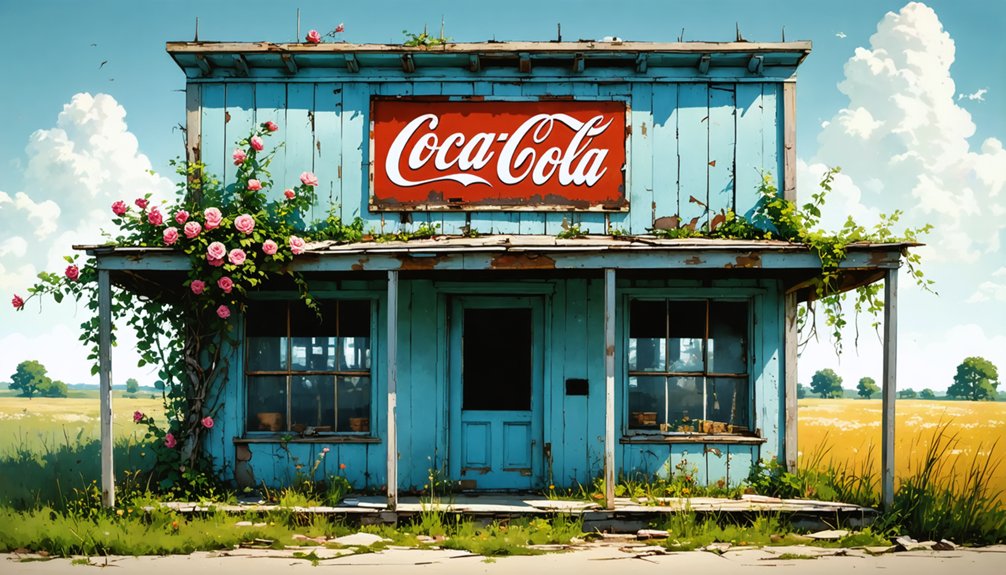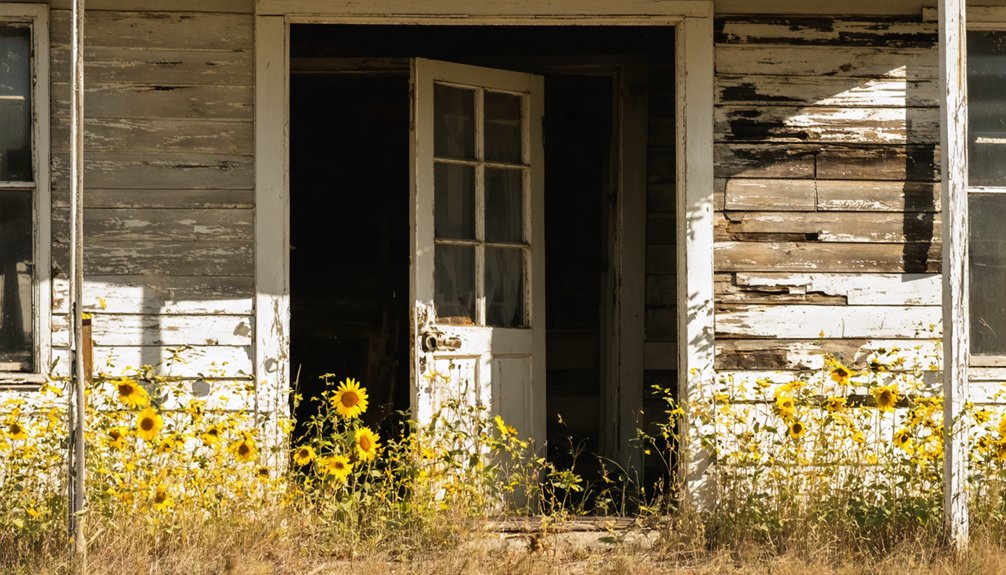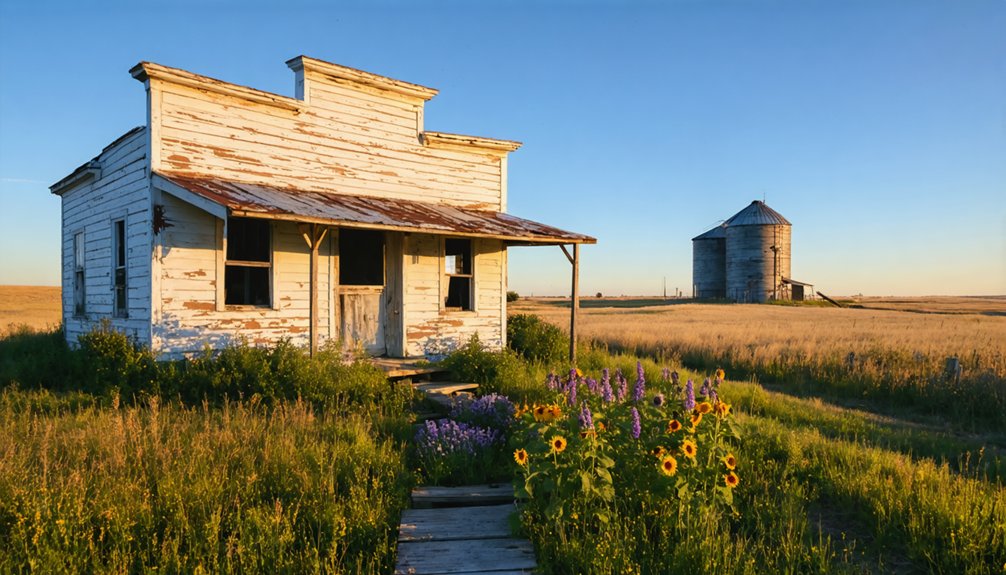You’ll find Floral nestled in South Dakota’s rugged Black Hills, a ghost town that emerged during the late 19th century’s mining boom. It thrived briefly as homesteaders built farms and ranches under the 1862 Homestead Act, with a post office, grain elevator, and general store serving the community. After the railroad’s decline and severe droughts post-WWII, only weathered foundations and scattered artifacts remain among the prairie grass, each holding untold stories of frontier life.
Key Takeaways
- Floral was established during the late 19th century near the Black Hills as a frontier settlement during South Dakota’s mining boom.
- The town’s economy relied heavily on railroad activity and nearby coal fields containing over 137 million tons of resources.
- Daily life centered around farming, mining, and surviving harsh prairie conditions, with basic structures including a post office and general store.
- Only crumbling foundations, weathered structures, and scattered artifacts remain among the prairie grass, telling stories of pioneer life.
- Visiting requires advance research and possible permission, as the ghost town location is unmarked with no public facilities or amenities.
Origins and Early Settlement
While many frontier towns emerged during America’s westward expansion, Floral, South Dakota took root as part of the late 19th century’s agricultural settlement wave. You would’ve found determined homesteaders, mostly from Midwestern states, facing settlement challenges as they carved out new lives on the prairie.
They established farms and ranches under the 1862 Homestead Act, building a self-sufficient community from the ground up. Their homesteading experiences centered around essential structures – the post office, grain elevator, and general store – which formed the heart of daily life.
Like many Black Hills communities, Floral’s growth depended on its strategic location near transportation routes and natural resources. Families worked together, pooling their labor and resources to transform this frontier outpost into a permanent settlement. The arrival of Concord stagecoaches brought vital connections to surrounding settlements, helping sustain the growing community. Much like the town of Mystic, Floral’s fate was sealed when harsh winters and changing economic conditions forced residents to abandon their homes.
Life in Frontier Floral
Life in frontier Floral painted a vivid picture of resilience amid harsh realities.
You’d find simple wooden cabins dotting the landscape, where multi-generational pioneer families weathered isolation and scarcity. During winter months, you’d struggle alongside your neighbors to maintain essential supplies through limited supply lines. Like many South Dakota settlements, Floral emerged as one of the towns established every seven miles to service steam locomotives. Much like Scenic’s Longhorn Saloon, the local watering holes served as key gathering places for weary residents.
Your social world would revolve around the local chapel and saloons, offering precious moments of connection in an otherwise demanding existence.
You’d face recurring challenges from floods and severe weather, while the ever-present threat of illness, including the devastating 1919 influenza outbreak, loomed over the community.
Despite harsh conditions, you’d witness remarkable pioneer resilience as residents banded together, finding comfort in church gatherings, community dances, and shared hardships that defined life in this frontier town.
Economic Rise and Fall
You’ll find Floral’s economic story began with the promise of Black Hills mining and railroad expansion, as entrepreneurs and settlers flocked to capitalize on mineral wealth and transportation opportunities.
When mines like Spokane and Galena yielded precious metals and the railroad brought steady commerce, Floral’s future seemed assured through the late 19th century.
Mining Boom’s Early Promise
As prospectors discovered gold in the Black Hills around 1875, South Dakota’s mining industry sparked a wave of economic optimism that would reshape the region’s destiny.
You’d have found yourself amid a territory being hailed as a “treasure house of precious minerals,” where early mining techniques yielded promising returns of $12 per ton from gold ore deposits.
The economic forecasts weren’t limited to precious metals. You could’ve witnessed the development of the Firesteel coal fields, estimated to hold over 137 million tons of coal.
The promise of mineral wealth transformed the landscape as mining towns sprung up, complete with homes, businesses, and essential services. Many amateur historians and friends provided valuable documentation about these early mining settlements.
Companies formed rapidly, drawing investors who saw unlimited potential in both gold and coal extraction, while milling technology evolved to handle the region’s unique mineral deposits.
Railroad Prosperity Fades Away
While the early railway era brought unprecedented prosperity to South Dakota between 1878 and 1887, the golden age of rail transport wouldn’t last forever.
You can trace the railroad decline through the stark transformation of towns like Floral, where empty depots and abandoned grain elevators tell the story of changing times.
- The 1930s drought dealt the first major blow, drastically reducing agricultural freight volumes.
- Post-WWII automobiles and trucks began replacing trains for both passenger and cargo needs.
- Railroad companies abandoned unprofitable rural lines, cutting off essential market connections.
- By 1969, the last passenger train service ended, symbolizing the complete transformation of transportation.
The transportation shifts left Floral increasingly isolated, as the once-bustling rail hub watched its economic lifeline fade away, taking with it the town’s prosperity and ultimately its population.
The decline was particularly severe, as rail mileage disappeared at an alarming rate until over 60% of the state’s tracks were gone by 1980.
Architectural Remnants
The crumbling bones of South Dakota’s ghost towns tell stories through their architectural remnants.
You’ll find scattered stone and timber foundations breaking through the prairie grass, marking where homes and businesses once stood. The foundation features reveal a mix of locally sourced materials – fieldstone, timber, and brick – laid directly on the ground without modern footings.
Crumbling stone and wooden beams pierce through wild grasses, revealing where pioneers once built their dreams upon raw earth.
Walking through Floral’s remains, you’ll notice architectural styles typical of frontier settlements, with fragments of handcrafted woodwork still clinging to deteriorating structures. Many structures feature weathered stucco and shingles, reminiscent of the old schoolhouse that once educated local children.
Metal roofing sheets and ornamental ironwork lie twisted among the ruins. Some buildings retain their original fireplaces and chimneys, standing as silent sentinels amid the decay.
Artifacts like bed frames and tools remain scattered around these skeletal foundations, offering glimpses into the lives of those who built this frontier community.
Tales From Former Residents

You’ll find rich stories of daily existence in Floral through the memories of those who once called it home, with former residents recounting the challenges of harsh winters and maintaining agricultural livelihoods.
Their tales paint vivid pictures of community gatherings at local halls, where dances and social events strengthened neighborhood bonds before the town’s eventual decline.
Through shared memories, you can glimpse how local landmarks like the school and church served as social anchors, fostering a tight-knit community spirit that former residents still cherish today.
Daily Life Stories
Living through Floral’s heyday meant embracing a rhythm of life dictated by nature’s cycles and community bonds. Family routines centered around essential tasks, while neighbors pulled together for community survival in the isolated Black Hills setting.
Your daily experience in Floral would have included:
- Dawn-to-dusk farm labor, tending to crops and livestock while adapting to harsh seasonal changes.
- Trading goods with neighbors and sharing resources during winter isolation, when dirt roads became impassable.
- Gathering for impromptu prayer meetings and social visits, where home remedies and survival skills were exchanged.
- Spending evenings by lamplight, engaging in storytelling, letter writing, or mending clothes while children practiced lessons learned in the small local school.
These rhythms of life forged resilient spirits and unbreakable bonds among Floral’s inhabitants.
Community Gatherings Remembered
Personal recollections of Floral’s community gatherings remain shrouded in mystery, with few documented accounts surviving to present day.
Unlike larger ghost towns in the Black Hills region, such as Rockerville, Floral’s local traditions have largely faded into obscurity, preserved mainly through connections with neighboring settlements.
You’ll find that community storytelling played a crucial role in maintaining the town’s identity, though specific details of Floral’s gatherings are scarce.
The pioneering spirit of early settlers fostered a deep sense of camaraderie through these events, reflecting the area’s rich mining heritage.
While preservation efforts continue, you’re more likely to encounter fragments of memories passed down through generations, highlighting the importance of oral histories in keeping Floral’s legacy alive.
Geographic Setting and Environment
Nestled in the rugged terrain of western South Dakota’s Black Hills, Floral ghost town stands as a silent reminder of the region’s mining heritage in Pennington County.
The area’s geological features reflect its tin mining past, with mineral-rich soils and rocky outcrops dotting the landscape. Today, only building foundations and scattered rubble remain visible at the site. The ecological impact of human settlement has largely faded, as nature reclaims this historic site. Like many abandoned settlements, the area has gradually reverted to its natural state.
If you’re exploring Floral today, you’ll encounter:
- Semi-arid climate conditions that shape the deteriorating remnants
- Mixed forests of ponderosa pine, spruce, and aspen surrounding the ghost town
- Small creeks and springs that once supported mining operations
- Abundant wildlife, including deer, elk, and wild turkeys roaming freely through the abandoned settlement
The town’s remote setting among rolling hills provides a stark backdrop to its neglected ruins and scattered foundations.
Historical Significance Today

While many ghost towns fade into obscurity, Floral’s remains hold profound significance as a symbol of South Dakota’s mining heritage.
You’ll find this former mining hub deeply woven into the cultural memory of the Black Hills, offering tangible connections to both indigenous and settler histories shaped by the Gold Rush era.
Today, Floral’s legacy lives on through historical markers and structural remnants that attract historians, photographers, and ghost town enthusiasts.
The area experienced intense conflict as Lakota and Cheyenne attacks occurred during the height of Black Hills settlement.
Though heritage preservation faces challenges due to natural decay and private property restrictions, the town’s story continues to inform academic research and public history projects.
You can explore Floral’s past through archival records and archaeological findings, which reveal fascinating insights into frontier life and the boom-and-bust cycles that defined 19th-century mining communities.
Visiting the Ghost Town
Unlike many documented ghost towns in South Dakota, Floral presents unique challenges for modern-day visitors due to its unmarked location and uncertain accessibility.
If you’re planning to explore this elusive site, you’ll need to navigate several visitor challenges and prepare carefully.
- Location remains uncertain – there are no marked roads, signs, or GPS coordinates to guide you to Floral’s exact position in Pennington County.
- Access may require advance permission, as the site could be on private property.
- No visitor facilities or amenities exist – you’ll need to be completely self-sufficient.
- Limited remnants await – expect only scattered rubble or foundations rather than intact structures.
For the adventurous explorer, visiting Floral becomes more of a historical detective mission than a typical ghost town experience, requiring thorough research and preparation.
Frequently Asked Questions
Are There Any Documented Paranormal Activities or Ghost Sightings in Floral?
Among South Dakota’s 200+ ghost towns, you won’t find documented ghost stories or haunted locations at Floral. There’s zero verified paranormal activity, making it one of many forgotten places without supernatural claims.
What Was the Peak Population of Floral During Its Most Prosperous Years?
You won’t find reliable records of Floral’s peak population in documented history. While the town’s decline is known, specific numbers from its most prosperous years weren’t consistently tracked or preserved.
Did Any Notable Crimes or Wild West Incidents Occur in Floral?
Like scrolling through Instagram and finding zero posts, Floral’s history shows no documented Wild West crimes or notable incidents. You won’t find any gunslinger tales or outlaw drama here.
Were Any Movies or Television Shows Ever Filmed in Floral?
You won’t find any movies or TV shows filmed in Floral’s history. While South Dakota boasts many film locations, this small ghost town hasn’t been documented as hosting any production crews.
Are Metal Detecting or Artifact Collecting Activities Permitted at the Site?
You’ll need proper permits and authorization since metal detecting regulations and artifact collection guidelines strictly limit these activities. Without permission, you’re not allowed to collect or disturb any historical items.
References
- https://www.youtube.com/watch?v=Glucs_Rq8Xs
- https://www.powderhouselodge.com/black-hills-attractions/fun-attractions/ghost-towns-of-western-south-dakota/
- https://www.sdpb.org/rural-life-and-history/2023-08-21/some-black-hills-ghost-towns-and-their-origins
- https://www.onlyinyourstate.com/experiences/south-dakota/scenic-abandoned-town-sd
- https://en.wikipedia.org/wiki/List_of_ghost_towns_in_South_Dakota
- https://www.southdakotamagazine.com/owanka-ghost-town
- https://mad-peak.com/blog-posts-and-info/f/galena-south-dakota-adventure-into-a-wild-west-ghost-town
- https://blackhillsvisitor.com/learn/spokane/
- https://www.youtube.com/watch?v=2zGg23yeB5w
- https://www.sdhspress.com/journal/south-dakota-history-2-2/some-black-hills-ghost-towns-and-their-origins/vol-02-no-2-some-black-hills-ghost-towns-and-their-origins.pdf



